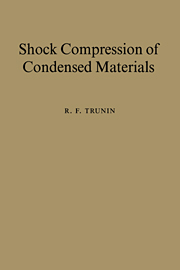1 - Introduction
Published online by Cambridge University Press: 03 December 2009
Summary
The all-out effort undertaken to produce weapons of nuclear deterrence that was started in the USSR after World War II demanded measurements of properties of various materials, including their shock compressibility, under high pressure. This research was prompted primarily by the necessity of rapidly closing the gap between the USA and USSR in nuclear military technology.
Measurements of material shock compression had been started in 1946, when research aimed at deriving equations of state of various materials was initiated as part of the nuclear program. These equations, which establish relations between thermodynamic parameters, such as energy (or shock compression temperature), and pressure or density, were needed to complete the equation system describing the compression of compressed continuous media.
The equations of state are based on experimental data on the shock compression of materials, in which pressure is determined as a function of density and energy called a shock adiabat (sometimes this relationship is named a Hugoniot equation of state). Unlike the USA, more attention in the USSR, especially in the first years of the nuclear program, was focused on the techniques and devices for studying equations of state of materials. The problem of primary importance was measuring parameters of explosives which triggered the nuclear reaction and metals from which the bomb structure was made. The pioneering research in this field was performed by L.V. Al'tshuler, E.I. Zababakhin, Ya.B. Zel'dovich and many other workers of the Russian Nuclear Center (formerly All-Russia Research Institute of Experimental Physics in Arzamas-16, presently Sarov in Nizhnii Novgorod region).
- Type
- Chapter
- Information
- Shock Compression of Condensed Materials , pp. 1 - 15Publisher: Cambridge University PressPrint publication year: 1998



